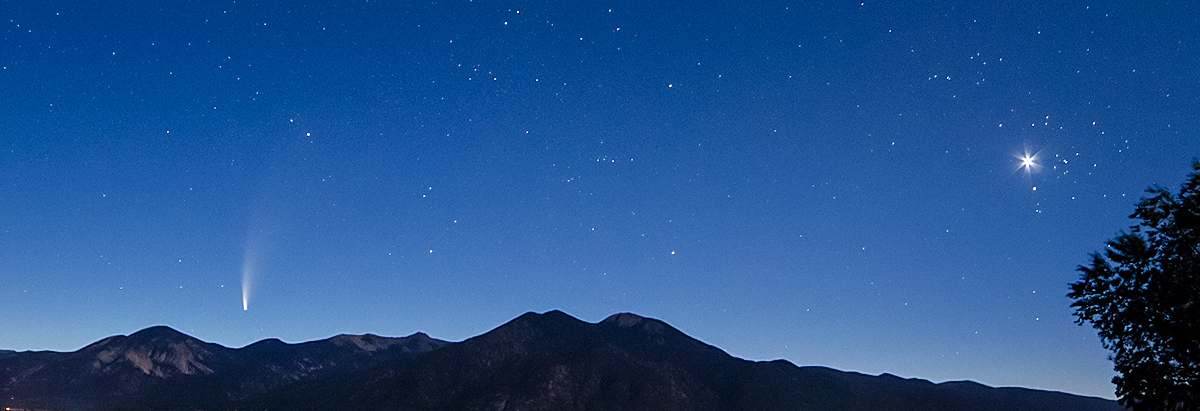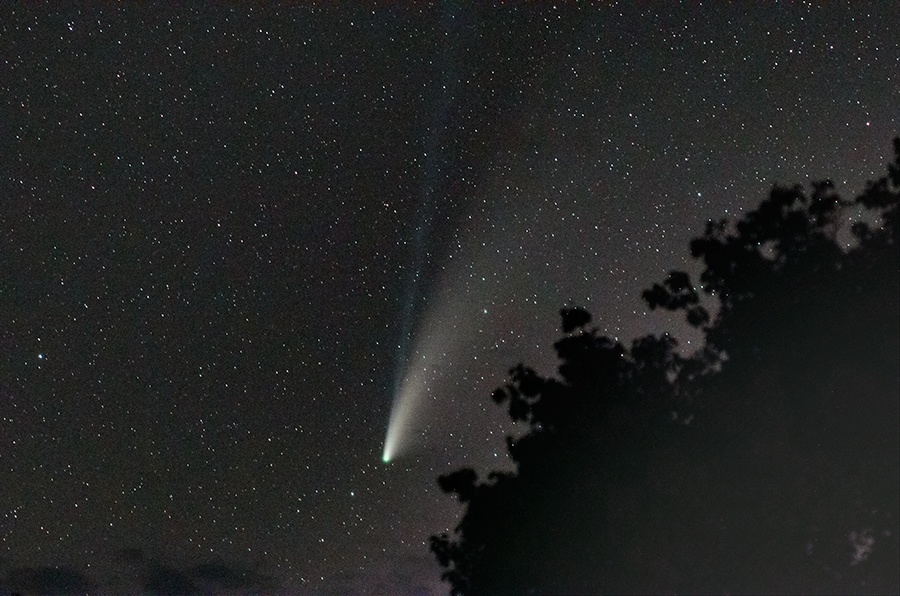
Welcome to taosastronomer.com!
offering
local "hands-on" observing
(visual and imaging) sessions and instruction
viewing and imaging from Rabbit Valley Observatory
a dark sky location on the mesa just west of Taos, NM
“Comet NEOWISE detail" -- 07/20/2020 |
 |
We viewed this lovely comet from our front porch and back yard(!) in early-mid July 2020. The daily specifics are on the index page blog, and give a good idea how one might chronicle such an event. I always recommend / perhaps "require" taking notes contemporaneously, as you will forget. My observing notes and photographic details for this image are as follows: First clear sky since 7/12/20; went up on the mesa, set up white iOptron SkyGuider Tracking EQ mount, reviewed polar alignment instructions (using cell ‘phone’s GPS to determine Polaris’ location on the polar finder’s reticle) and waited. I had determined that an 85mm lens (mounted on the ball head) would be just about right, given the recent photographs published on the web, and considering a rough estimate of the size of the comet’s tail. I focused to infinity — always required for astrophotography and slightly to the right of this lens’ preset mark — on a distant airport light, and waited. Although waiting for nightfall and a glimpse of the comet was a very calming exercise, nevertheless as it got darker, a huge cloud started to obstruct the northern sky. So, after much planning and waiting, I finally gave up, about 21:30 MDT and drove the short distance home (5 minutes). Upon arriving back home, those clouds had already started clearing out, so I unloaded and viewed with the Pentax XCF 12X50 binocs (FOV is 5.6 degrees). And, perhaps about 22:00 MDT it did clear up, and the beautiful Comet NEOWISE was fully exposed. Visually, you could just make out the comet’s ion tail as well as a very obvious, even with the naked eye, its dust tail. Estimated (difficult for such an extended object) magnitude was 1.5. After 20 minutes or so of viewing, the sky remained clear; so I decided to take a few non-guided “snapshots” of the comet. I put the ball head on the regular tripod and composed the pics, best one as pictured here. I set the exposure time for 8 seconds (500 rule suggests 4 seconds to avoid star streaking with this config), guessing (slightly incorrectly) that any longer would show too many star trails on an unguided platform. To compensate, I set the ISO at a noisy 6400, and shot one stop down at f/2.8. As the comet started to set, clouds also reappeared, but frankly I think I was lucky to see and photograph it at all! One additional notation — there was a constant barrage of satellites “flowing” through the field of view, essentially ruining many of my photographs. Some observers and photographers have previously noted that “they” were the ISS, but there were quite a few, suggesting the new barrage of communications satellites recently put into orbit. Concluding, visually the comet was at least 6 degrees long, ion tail barely visible to the naked eye, yellow/whitish dust tail obvious, long, and spread out. Specific data below: Comet NEOWISE below pointer stars of the Big Dipper, taken on a fixed tripod from our back “yard.” (Nikon 5100, Nikon 85mm f/2 lens at f/2.8, ISO 6400, 8 seconds, 22:24 MDT, 07/20/2020)
[copyright Rabbit Valley Observatory/Willis Greiner, 2020 -- all rights reserved] |
(all content copyright 2015-2020 Willis Greiner Photography, all rights reserved)